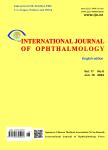Surgical outcomes for unilateral superior oblique palsy in Chinese population: a retrospective study
Surgical outcomes for unilateral superior oblique palsy in Chinese population: a retrospective study作者机构:Department of OphthalmologyCaritas Medical Centre Department of AnatomyFaculty of MedicineUniversity of Hong Kong
出 版 物:《International Journal of Ophthalmology(English edition)》 (国际眼科杂志(英文版))
年 卷 期:2015年第8卷第1期
页 面:107-112页
核心收录:
学科分类:1002[医学-临床医学] 100212[医学-眼科学] 10[医学]
主 题:superior oblique palsy vertical deviation surgery diplopia
摘 要:AIM: To evaluate the outcome after surgery for unilateral superior oblique(SO) palsy in ***: The medical records of 39 patients that underwent surgery for unilateral SO palsy between January 2003 and December 2012 at Caritas Medical Centre, Hong Kong, were retrospectively reviewed. All surgeries were performed by a single surgeon. Pre-operative assessments for vertical deviation, cyclo-deviation, and Knapp’s classification were obtained to determine the nature and degree of surgical *** deviation was measured at 1wk; 1, 6mo and on last follow-up day post-operatively. Cyclo-deviation was measured on last follow-up day ***: During the 10 y period, 39 subjects were recruited. The most common etiology was congenital(94.9%). Knapp’s Type III(66.7%) and Type I(12.8%)classifications were the most common subtypes. To treat SO palsy, the most common surgical procedures were:isolated inferior oblique(IO) anteriorization(41.0%),isolated IO myectomy(10.3%), and isolated IO recession(10.3%). At 3.5 ±2.1y post-operatively, the vertical deviation was significantly reduced(15.1 ±6.2 PD versus0.5±1.4 PD, P 0.0001) without significant improvement in cyclo-deviation(P =0.5). Initial vertical deviation was correlated with cyclo-torsion(r =0.4, P =0.007). Those with over-correction had greater initial vertical deviation(19.4±7.2 PD versus 13.2±4.3 PD, P =0.003). After a single operation, 84.6% of subjects achieved a vertical deviation within ±3 PD.· CONCLUSION: The majority of subjects achieved corrected vertical deviation after a single surgery although there was no improvement in *** with over-correction of primary position deviation had greater preoperative vertical deviation and it may be related to simultaneous multiple muscle surgery.



